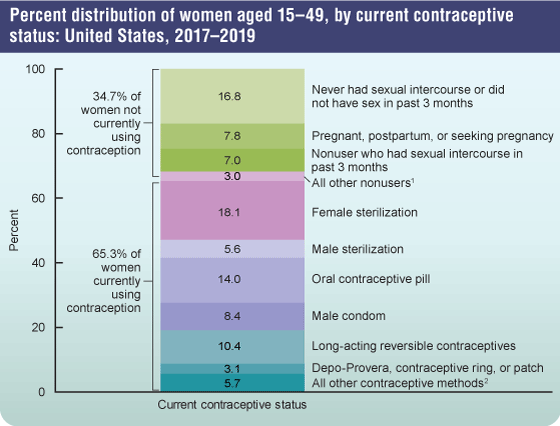National Survey of Family Growth
NCHS Fact Sheet, May 2021
About NCHS
The National Center for Health Statistics (NCHS) is the nation’s principal health statistics agency, providing data to identify and address health issues. NCHS compiles statistical information to help guide public health and health policy decisions. Collaborating with other public and private health partners, NCHS uses a variety of data collection mechanisms to obtain accurate information from multiple sources. This process provides a broad perspective on the population’s health, influences on health, and health outcomes.
National Survey of Family Growth
The National Survey of Family Growth (NSFG) collects information on fertility, families, and health from a nationally representative sample of males and females aged 15−49 in the household population of the United States. NSFG was conducted five times periodically between 1973 and 1995 with a national sample of females aged 15−44. A sixth periodic survey, conducted in 2002, included both males and females aged 15−44. In June 2006, NSFG shifted to a continuous survey design interviewing males and females. Apart from a break in fieldwork from July 2010 through August 2011, NSFG data collection was conducted continuously through September 2019. In September 2015, the survey’s age range for males and females was expanded from 15−44 to 15−49.
Topics addressed in NSFG include:
- Women’s pregnancy and birth history, and men’s fathering of biological children
- Breastfeeding
- Adoption and nonbiological parenting
- Contraceptive use
- Intendedness of pregnancies
- Sexual intercourse and number of sexual partners
- Family planning and related medical services
- Infertility and use of infertility services
- Attitudes on sex, parenthood, marriage, and cohabitation
- Men’s involvement as fathers with children they do not live with
- Other sexual behaviors (besides vaginal intercourse) that may carry risk of HIV or
sexually transmitted infections, including same-sex behavior - Sexual orientation and attraction
Current contraceptive status
During 2017–2019, the most common methods of contraception currently used among women
aged 15−49 were:
- Female sterilization (18.1%)
- The pill (14.0%)
- Long-acting reversible contraception (e.g., intrauterine devices and implants) (10.4%)
- Male condom (8.4%)

1Additional categories of nonusers, such as nonsurgical sterility, are shown in the accompanying data table.
2Other methods grouped in this category are shown in the accompanying data table.
NOTES: Percentages may not add to 100 due to rounding. Women currently using more than one method are classified according to the most effective method they are using. Long-acting reversible contraceptives include contraceptive implants and intrauterine devices. Access data table for this figure at https://www.cdc.gov/nchs/data/databriefs/db388-tables-508.pdf#page=2.
SOURCE: National Center for Health Statistics, National Survey of Family Growth, 2017–2019.
The percentages of women currently using any contraceptive method during 2017–2019 showed:
- About 65% of women aged 15–49 were currently using a method of contraception.
- Current contraceptive use increased with age, from 38.7% among women aged
15–19 to 74.7% among women aged 40–49. - The percentage of non-Hispanic white women currently using contraception
(69.2%) was higher compared with non-Hispanic black women (61.4%) and
Hispanic women (60.5%). - Current contraceptive use did not differ significantly by education.
Marriage and cohabitation
During 2017–2019, 49% of women and 47% of men aged 15–49 reported that they had
ever been married. More than one-half of women (59%) and men (54%) aged 15–49 during
2017–2019 had ever cohabited outside of marriage.
Additional findings from the 2017–2019 NSFG
- About 24% of men aged 45−49 had not fathered any children, 17% had fathered
one child, 35% had fathered two, and 23% had fathered three or more children. - About 16% of women aged 45−49 had not had any children, 17% had one child,
34% had two, and 33% had three or more children. - About 22% of women aged 15–49 and 13% of men aged 15–49 had been tested
for HIV outside of blood donation in the past year. - Approximately 49% of women aged 15–49 received a Pap test in the past
12 months. - The average number of children expected by women aged 15−49 in their lifetime was 2.1.
- Among men and women aged 15–49, 1.9% of men and 1.0% of women had sexual
intercourse with five or more opposite-sex partners in the past year.
Challenges and future opportunities
After data collection concluded in September 2019, the 2017−2019 NSFG public-use data files were released in October 2020. NSFG data collection will resume with independent samples of men and women aged 15−49 in January 2022. Under the continuous fieldwork model, pending the availability of funding, interviewing will go through December 2029. The survey’s focus remains on continuity of measures in core areas and adapting as needed to respond to changes in data needs in reproductive health, family planning, and family formation. The survey also will continue to implement strategies to make continuous interviewing as efficient as possible in light of declining response rates and other operational challenges faced by all surveys. NSFG strategies for the future include the use of web-based interviewing in addition to traditional in-person interviewing.
For more information about NCHS, visit https://www.cdc.gov/nchs/.
For more information about NSFG, visit https://www.cdc.gov/nchs/nsfg.htm.